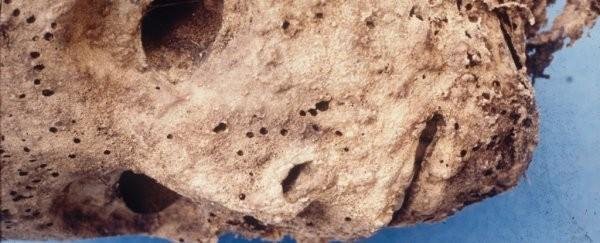This 400-Year-Old Mummified Body Could Change Our Understanding of Hepatitis B

A two-year-old boy who died around 1569 turns out not to have died from smallpox, as previously thought, but what we now know to have been Hepatitis B .
Thanks to scientists who sequenced the genome of his mummified body.
This finding marks a confirmation that the mysterious illness has existed in humans for centuries, said researchers from McMaster University in Canada.
The child in question was buried in the Basilica of Saint Domenico Maggiore in Naples, Italy, around 440 years old, give or take 60 years. Its body was exhumed between 1983 and 1985, and the pock-marks all over led researchers to believe smallpox - the Variola virus - was the cause of death.
Immunostaining and electron microscopy seemed to confirm the presence of smallpox particles in these pustules, and the case has been an important one in establishing the human history of smallpox, having been considered the oldest evidence for the virus in Medieval remains.
But the new evidence tips that theory right out the window.
"These data emphasize the importance of molecular approaches to help identify the presence of key pathogens in the past, enabling us to better constrain the time they may have infected humans," said evolutionary geneticist and lead investigator Hendrik Poinar .
In small children, Hepatitis B, a liver infection that the CDC estimated kills 786,000 people around the world every year , can cause a blistering facial rash on the face, legs, buttocks and arms - all places where the mummy showed pockmarks.
This is why the infection may have been misdiagnosed and shows one of the significant problems with trying to diagnose illnesses from the past.
To determine that the illness was Hepatitis B, the researchers took small samples of skin and bone, stitching together pieces of genetic information to try and get a more complete picture.
The result was a complete Hepatitis B genome found in the mummy - and no smallpox.
They also used scanning electron microscopy, and didn't find any evidence of particles resembling smallpox or Hepatitis B, although they did find particles of a virus of unknown origin - suggesting that the mummification process may change the physical appearance of viral particles.
This could explain why the earlier result showed particles that may have resembled smallpox. It also highlights the importance of confirming diagnoses.
"This illuminates the power of a DNA in providing definitive evidence or clarifying retrospective diagnoses, where etiology may be uncertain and morphology complicated for key type specimens that provide critical time points for the origins or presence of specific pathogens," the researchers wrote in their paper .
Interestingly, the results showed a close relationship between the Hepatitis B from the 16th century and modern Hepatitis B, suggesting it hasn't evolved much at all, even though viruses typically evolve quite rapidly.
They also couldn't find a temporal structure in either the 16th century or present-day versions of the virus - that is, evidence of evolutionary changes made over time, a sort of timeline of how and when the virus changed. This means that the researchers could not use the molecular clock method to try and gauge the origin of the virus.
Nevertheless, the discovery sheds some light on the history of Hepatitis B, and may hold important clues for figuring out how to manage it today.
"The more we understand about the behaviour of past pandemics and outbreaks, the greater our understanding of how modern pathogens might work and spread, and this information will ultimately help in their control," Poinar said .
I think history hold the answers we need, we are just not looking hard enough. Lets hope they do find a way to manage it or better eliminate it.
Hi! I am a robot. I just upvoted you! I found similar content that readers might be interested in:
http://www.conspiracy-nation.com/join-the-revolution/this-400-year-old-mummy-could-change-our-understanding-of-hepatitis-b/